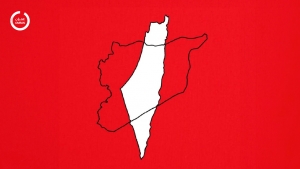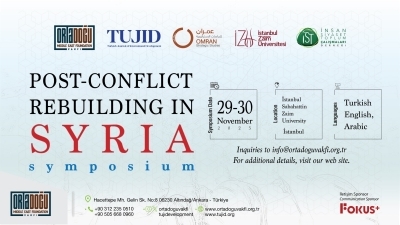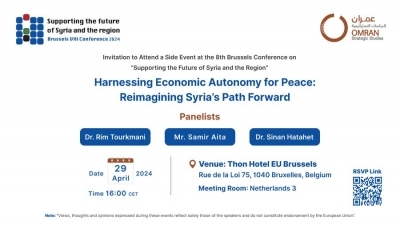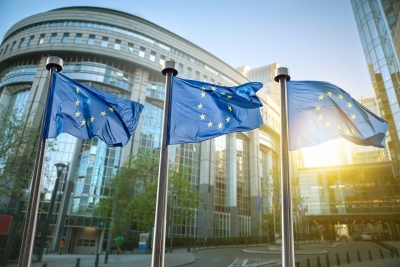Reports
Gaza War: The Responses of Syria’s Local Actors
Given Syria's involvement in the Arab-Israeli conflict since 1948, solidarity with Palestine has been a fundamental element within Syria's political culture. Regarding Syria's local actors’ stances on Gaza war (Syrian regime, Syrian opposition, “Hayat Tahrir al-Sham”, and “Syrian Democratic Forces”), while there is consensus in expressing solidarity with the Palestinian people in Gaza, their approaches to the war varied significantly in respective to their stances on Hamas, the “al-Aqsa flood” operation, and how they used the war in their different political strategies. These differences stemmed from a blend of ideological political identities on one hand and objective considerations related to their different relations with international and regional actors on the other. This article provides insight into the discourse projected by these actors on Gaza.
The Syrian regime has consistently propagated a narrative of resistance since the onset of the Gaza war, publishing official statements through its foreign ministry or speeches delivered by its prominent figures, notably Bashar al-Assad and his Foreign Minister, Faisal Mekdad. The regime praised the “al-Aqsa flood” operation as a “glorious achievement,” linking it to the October 1973 war due to its historical significance as a victory within the Syrian and Arab narrative.
Using the Gaza war in emotional mobilization of its popular incubator and its narrative of conspiracy, the regime associated the Israeli aggression with the ongoing struggle in Syria, holding Israel accountable for supporting the perpetrators of the drone attack on the Homs Military Academy on October 5th. This sentiment was further underscored by Mekdad when he criticized the stances of the United States and European states on Gaza accusing them of “Western deceit and open appetite for killing Arabs, including Palestinians.” In response to Israeli escalation of targeting various Iranian and regime sites in Syria, the regime continued to propagate a discourse centered on the right to defend sovereignty and reclaiming the Golan Heights within the 1967 borders.
By political means, the Syrian regime leveraged the regional atmosphere after the Gaza war to bolster its diplomatic activity within the Arab League and its bilateral diplomatic engagement with various Arab countries. While Assad advocated for halting the process of Arab-Israeli normalization during the extraordinary joint Arab Islamic summit on Gaza in November, the regime did not record formal reservation on any of the summit's resolution provisions, including having “normal relations with Israel,” a reservation upheld by Algeria, Iraq, and Tunisia (1).
This reflects the regime's alignment with the official and prominent Arab stance concerning the Israeli aggression on Gaza in formal diplomatic means, while concurrently maintaining a vehement anti-Israeli and anti-Western sentiment through its rhetoric, as a cornerstone of the “axis of resistance” led by Iran.
“Hayat Tahrir al-Sham” adopted a different narrative toward the “al-Aqsa flood” operation in comparison to jihadist groups - al-Qaeda and its branches - that advocated in their statements for jihad and targeting Western sites in Muslim countries. HTS's official rhetoric, expressed through statements by its “Syrian Salvation Government,” revolved around praising the operation carried out by Hamas, endorsing the Palestinian people's right of “the entire liberation of Palestinian land,” and calling on the “international community and Arab nations” to halt the Israeli aggression on Gaza after the Israeli targeting of Jabalia refugee camp. HTS’s call, in essence, mirrored a statement issued earlier by the Taliban government, which has been promoted as a “model” by prominent figures within HTS.
As it has been promoting itself as a moderate actor, the SSG’s Ministry of Media issued -ironically- a statement on press freedom and condemned the Israeli targeting of journalists regardless of their faith. This condemnation included Israeli violations of the targeting of journalist Wael al-Dahouh's family, the killing of journalist Sherin Abu Akel in Palestine, and the targeting of journalist Carmen Joukhadar in Lebanon.
At the same time, the jihadist element remained present in the speeches of HTS figures, notably Abdul Rahim Atoun, the head of its Fatwa Council. He said that the conflicts in both Syria and Palestine constitute a jihad that is an "obligation" upon every Muslim. This declaration was made during a symposium titled "From Idlib to Gaza... One Wound," organized by the SSG’s Ministry of Media. This highlights the tone difference in the technical statements and media discourses as well as the continuation of the jihadist ideological element within HTS's narrative.
Nevertheless, the primary objective of the symposium was to draw parallels between the Palestinian resistance against Israel and the Syrian struggle against the regime. The focus was on highlighting the similarities in crimes committed against the Syrian and Palestinian people, by the Assad regime and Israel respectively. This narrative resonated with SSG’s official statement, which regarded Palestinian resistance as an inspiring model for the struggle against the Syrian regime. A narrative aligns with HTS's efforts to project a national-Islamist image at the expense of its former Jihadist one.
As for the Syrian Opposition, the Syrian Negotiation Commission, the Syrian National Coalition, and the Syrian Interim Government expressed solidarity with Gaza, particularly following the bombing of al-Maamadani Hospital. Both the statements from the Negotiations Committee and the National Coalition condemned the crimes committed by Israel and emphasized the significance of the Arab Peace Initiative (2002), rejecting the forced displacement of Gaza residents. Simultaneously, the Interim Government condemned the crimes of the Israeli occupation and declared a three-day national mourning in its controlled areas.
Regarding their stance on Hamas or “al-Aqsa flood,” there hasn’t been any official statement or position issued on the matters, given the challenge of attaining a unified stance within the opposition due to the varying and sometimes conflicting positions toward Hamas, driven by ideological or political reasons related to Hamas's stance on the Syrian regime or Iran. Let alone the objective considerations related to the opposition’s political relations with international and regional actors.
As for the “Syrian Democratic Forces,” the SDF-affiliated “Syrian Democratic Council,” issued a statement condemning the targeting of civilians in Gaza, particularly the al-Maamadani Hospital, taking into consideration the pro-Palestinian sentiment among Syrians. The statement made reference to the “right of the Palestinian people to self-determination,” in line with SDF’s claim of the “Autonomous Administration” in Northeastern Syria. On Hamas, the head of the SDF, Mazlum Kobane, condemned it, yet expressed concerns over the Israeli objective to eradicate Hamas because of the potential spillover effects of such eradication.
The response of local actors in Syria to the Gaza conflict varied significantly in their level of engagement, political stances, and the use of the war in their narratives. There has been notable and active engagement by the regime and HTS, moderate engagement from the opposition, and cautious one from the SDF. The regime leveraged the Gaza war in emotional mobilization within its popular incubator as a cornerstone of the resistance axis by endorsing Hamas. Simultaneously, the regime has politically capitalized on the regional atmosphere to strengthen its diplomatic presence within Arab politics. HTS has also used the war in emotional mobilization in Idlib and in its rebranding process as a local actor endorsing Hamas as a model. In contrast, the opposition limited its response to humanitarian solidarity with Gaza, refraining from issuing an official stance on Hamas. The SDF pursued minimal engagement with Gaza and was the only actor to take an anti-Hamas stance along with fearing the repercussions of the war.
Finally, the result of the war on Gaza, will have impact on these actors, particularly for HTS and SDF, at least in terms of boosting their confidence to survive as semi-state actors in case Hamas survives the Israeli military campaign or diminishing that confidence in case Israel manage to eradicate Hamas.
([1]) This stance followed the regime's prior formal reservation on “any wording that could be interpreted to equalize between the Israeli occupier and the Palestinian people living under occupation,” in the resolution of the extraordinary ministerial session of the Arab League on Gaza in October, akin to reservations expressed by Iraq, Libya, Algeria, as well as Tunisia which objected to the resolution entirely, advocating for “the right of the Palestinian people to establish their independent state on all of the territory of Palestine.”
Transformations of the Syrian Military: The Challenge of Change and Restructuring
Executive Summary
- Throughout its history, the Syrian military has gone through a number of stages in its structural and functional evolution. These include processes undertaken based on the need to develop the military’s professional and technical capacity, or as required for the domination and control of the regime over the army, or as dictated by the war conditions. But since Hafez al-Assad took power, the military has become a major actor in local “conflicts,” whether as a result of the social composition of the military and the sectarian engineering efforts started by Hafez al-Assad and continued by Bashar al-Assad, the special privileges granted to military members, or as a result of the military doctrine that is customized for the preservation of the regime and not based on national ideals. Some of the most significant structural and human changes in the history of the Syrian military took place between 2011 and 2018. These shifts included the entry of auxiliary non-Syrian forces, both individuals and groups, which completely changed the role of the “army” from that of a traditional national army into a force used primarily to protect the ruling regime.
- As a result of the unexpected outbreak of military operations across the country against a popular uprising, there was a significant increase in the number of amendments made to laws governing the military establishment in order to address gaps in those laws. Some of the laws were ignored in favor of custom and tradition. This was reflected in the promotion and evaluation of officers based on sectarian or regional affiliations. The introduction of a partial mobilization in Syria without official certification of the decision as a result of the events starting in 2011, and the issuance of a new mobilization law at the end of 2011, supported the regime's efforts to distribute mobilization tasks to all state institutions and departments. Previously, the last law on mobilization had been issued in 2004.
- At the outset of the uprising in Syria, the military's deployments were characterized by complete chaos. The regime's use of local and foreign militias, in addition to the Iranian and Russian regimes, transformed this deployment from complete chaos to a more organized chaos. The regime was able to recapture many villages and cities based on a strategy of collective punishment, scorched earth offensives, and guerrilla warfare. The Syrian regime's use of local and foreign militias led to an imbalance in the structure and responsibilities of the army during the revolution, so that the military became a more Alawite-dominated institution because of its reliance on its Alawite members. Most of the officers were corrupt, and that corruption became much worse during the years of revolution, causing the military to become increasingly distant and isolated from society. This pushed the officers to collude with corrupt networks within the regime and to exploit them to achieve further gains and accumulate wealth.
- In 2018, the military landscape witnessed many major transformations, most notably the division of the country into three main international spheres of influence, each of which contained a diverse mix of local political powers. In the first sphere controlled by the regime, there were indicators of increased Iranian and Russian influence, as well as an attempt to consolidate the militia scene, with some being dissolved and others linked to Iran being integrated and merged with others. In the second sphere: includes the armed opposition forces in northern Syria backed by Ankara, the map of relevant armed actors became more disciplined and contained under the framework of the Astana talks. Opposition forces displaced from southern and central Syria were restructured by Ankara in support of the Euphrates Shield and Olive Branch operations. In the third sphere: the Syrian Democratic Forces (SDF) continued to perform their security and military functions under the self-administration project and its legal framework. At the same time, their negotiations with the Assad regime continued, leaving their options wide open and making it more likely that the situation would get more complicated because of the lack of a clear policy from the Americans who supported the SDF on the one hand and pushed for further negotiations on the other.
- The regime’s attempts to reduce and contain the roles carried out by Iranian and local militias were not comprehensive or well organized. On one hand, many Iran-backed militias became integrated into the official regime military structure following the formalization of Iranian operations in Syria, which did not reduce or contain its power or impact. On the other hand, the overall reintegration strategy was not adhered to especially with regards to local militias or groups that settled through reconciliation agreements, as the objective of conducting operations against opposition forces is still prevalent and dominating deployments. This process of reintegration will face further obstacles that will greatly hinder any restructuring process as a result of the deep infiltration of such militias and the diverse roles they play in society and within the security sector.
- The data and indicators examined by the papers contained in this book highlight the deep and significant impact of transformations in the military institution both in the medium and long terms. These transformations are observed in the structural and functional imbalances of the military institution especially as it faces a deficit of power, capacity, and resources. Furthermore, the regime’s military institution has become one of many other actors in the scene and often held hostage to local and international networks of power, whether it is the Russian or Iranian or other local groups. It is also restricted in its capacity because its imbalanced societal composition, has not adopted political neutrality, and the ideological party doctrine that dominates. All this necessitates a rebuilding strategy that is absent from the current regime’s agenda as well as its allies in favor for superficial rehabilitation for the purpose of regaining control of territory and society.
- In the face of the current frame of reference that guide the reform course of the military institution, the absence of a national agenda or vision should be noted. This vision should stipulate the requirements for the reform process, most important of which is the political process and change, depoliticizing the military institution, protecting political life from military interferences, and the reinforcement of healthy and normal civil-military relations that enhance its performance.
Introduction
Based upon the need to redefine the roles of the Syrian military institution in light of the profound transformations in the concept of nation-state, Omran Center for Strategic Studies launched this research project to further analyze those transformation and address the challenge of change and restructuring. The approach first deconstructs and assesses the functions and structures of the Syrian army, its doctrine, and causes behind its involvement and interference in social and political affairs in accordance with the regime’s philosophical vision of domination and totalitarian control. The papers contributed by researchers in the first phase of this project are as follows:
- The Syrian Army 2011-2018: Roles and Functions
- Military Actors and Structures in Syria in 2018
- Stability and Change: The Future of the Military in Syria
- Annex Report 1: Significant Transformations in the Army: 1945-2011
- Annex Report 2: Laws and Regulations Governing the Military After 2011.
The outputs of papers and reports in this book assess indicators of instability in the map of military actors and measure its impact on the centrality of defense and security functions and the future end game for the nodes of power within the military after possible reintegration processes. It also focuses on the relationship between the military and political spheres, in the sense that it evaluates the potential for military actors to contribute to various avenues of reform, including the redistribution of power in a legally decentralized manner. Similarly, it also looks at the changing political situation and the positions taken by regional and international backers of armed groups, which influence the decisions of military actors, leaving them with limited options.
This book first outlines the main historical developments in the Syrian military in order to establish a more comprehensive understanding of the shortfalls in the military structures and how they developed. It also looks at the most important laws and amendments related to the military establishment and how they have evolved over time. The book also describes how the military leadership used these laws after the start of the Syrian revolution to recruit fighters to the military that were completely loyal to the ruling regime.
The papers and reports in this book try to answer a number of key questions such as: does the military in its current state embody features of effectiveness, adopt a national outlook, have the capacity and ability required to preserve and promote the outputs of a political process, and able to create and promote conditions for stability? Addressing these questions necessitated first to recognize the positioning of reform policies within the current and future military institution agenda, and to assess the presence or lack of a cohesive and stable structure after the profound transformations it witnessed. Finally, the book outlines an initial vision for a framework for reform that would allow this institution to be a catalyst for societal cohesion and adopt a politically neutral position to become a source of stabilization is Syria.
Omran Center plans to launch a second phase with additional papers to be based on the outcomes of papers contained in this book as well as discussion and feedback received from participants in the workshop held in Istanbul on October 25th, 2018 to focus potentially on the following topics:
- Sectarianization mechanisms in the Syrian military.
- Power nodes and networks in the Syrian military.
- Management of surplus manpower: a case study of the 4th and 5th corps.
- The military judicial system.
- Non-technical challenges in the reform of the military establishment.
For More Click here
Battle of Deir ez-Zor & Raqqah September & October 2017
- October 9, Syrian Democratic Forces reportedly continued their advance in the eastern Deir-Ez-Zor governorate, capturing Mweileh town in Sur subdistrict, located north of Sur city.
- October 10, Syrian Regime offensive is largely dependent on Russian aerial coverage; the Russian Foreign Ministry announced that 150 daily Russian airstrikes had targeted ISIS bases in Mayadin city.
- October 15, SDF spokesperson announced that all willing combatants have evacuated the city; however, the likely destination of potential ISIS-affiliated evacuees is currently unknown. Furthermore, the SDF-led ‘Wrath of Euphrates’ operation against ISIS has led to SDF control over most neighborhoods in Ar-Raqqa city amidst heavy aerial support by the U.S.-led coalition, resulting in a high rate of civilian displacement.
- October 15, Syrian Regime forces and Allied Militias, supported by Russian aerial and ground forces, continued their advance south of Deir-Ez-Zor city, Syrian Regime forces, advanced into Al Mayadin city, Al Mayadin subdistrict, located 43.8 km south of Deir-Ez-Zor city.
- October 17, About 400 Islamic State (ISIS) members, including foreign fighters, have in recent weeks surrendered to U.S. backed forces in ISIS former Syrian stronghold Raqqa; inside source confirmed that the ISIS Syrian fighters were transferred to "Ayn Issa" Camp, while the foreign fighters were transferred to "Suluk" Military headquarter.
- October 18, Syrian Democratic Forces reportedly captured the several villages from ISIS, 7 KM eastern side of Deir-Ez-Zor City.
Important Note: As of the end of September, nearly 708,000 individuals are reported to still remain in ISIS-held communities in Deir-Ez-Zor governorate. This includes approximately 120,000 individuals in ISIS-held northern Deir-Ez-Zor governorate between Tabni, Tabni subdistrict, Deir-Ez-Zor City and the Euphrates River; 68,000 individuals in the ISIS-controlled western Deir-Ez-Zor governorate from Khasham in Khasham subdistrict to Markada across Khabour River; 120,000 in southern Deir-Ez-Zor governorate from Hajin to Abukamal; and nearly 400,000 individuals in the central Deir-Ez-Zor governorate.




